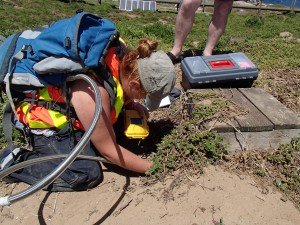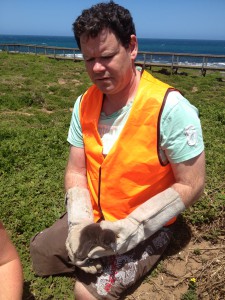Little Penguin Monitoring outcomes reflect the effect of varying environmental conditions
This season has thrown a number of significant challenges at our seabirds of the south eastern coast. As mentioned in previous blogs, a neutral ENSO phase this year has contributed to rough oceanic weather and currents, as well as high sea surface temperatures, resulting in lowered food availability.

sea surface temperatures have been increasing by an average of 0.16 degrees every ten years since 1970 (Bureau of Meteorology)
The prolonged heat wave last week also affected sea temperatures and food availability, and land based temperatures caused stress to nesting adult seabirds and their chicks. This would have been a particular challenge for recently fledged chicks and young adults who have only just started to strengthen their foraging skills.

Anomalies in average sea surface temperatures show an increasing trend over the last few decades (Bureau of Meteorology)
Monitoring results of the Little Penguin colony at Middle Island so far this season reflect these environmental conditions. The number of adults arriving to the island at dusk, measured through the arrival counts each fortnight of the breeding season, have shown to be on average around 30% less than what was found last season, after a steadily positive trend in numbers over the last 6 years.
Few pairing adults have also been found during the fortnightly breeding surveys, so far with only two clutches of eggs producing a total of three chicks observed. While these surveys only measure a subset of the nests present on the island, the occupancy and resulting breeding success within the surveyed area is considerably lower than the last few years.
Furthermore, in our last dusk count in January volunteers observed only 13 little penguins arriving, at a time when we usually expect to observe the highest arrival number for the season. There are a number of factors that may explain this event.
Because of the apparent lack of food availability and foraging success early in the breeding season, a large proportion of adult Little Penguins may have aborted their breeding activities, and began to forage for longer periods instead of returning to the island most nights for breeding duties. Higher than average mortalities due to sea based pressures may have also lowered the number of adults forming the colony.
Observations have been made at colonies across the southeast coast of adults beginning their annual moults prematurely – this may be in response to the absence of breeding activities and subsequently the onset of food availability coinciding with the Bonney upwelling in late November. During the moulting phase which may last up to three weeks, the penguins are not able to forage at sea, hence do not show up at dusk during the arrival counts.
Natural fluctuations in mortality and recruitment occur in all seabird species, often most related to the environment at sea. An odd ‘bad’ year would not be anything out of the ordinary. However if the extremity and frequency of weather conditions that usually result in a bad year increases, then the impact to seabird colonies in the long term may become much more significant.
Continued warming of Australia’s oceans and currents in the next few decades is predicted to alter the habitat and food availability of a large proportion of seabirds, causing an increase in foraging efforts and distances travelled. It is known that breeding Little Penguins travel further when there are elevated sea surface temperatures, which can significantly impact their chances of successfully rearing young if they can’t alternate their foraging and nest guarding duties effectively.

Climate modelling predicts significant average Sea Surface Temperature rises over the coming decades (Bureau of Meteorology)
Long term seasonal monitoring of the Middle Island Little Penguin colony size and breeding outcomes is proving to be more and more important. It illustrates the variability in colony size and breeding success between seasons, and in the absence of land based canid predation, we can suggest how the current environmental conditions at sea, such as sea surface temperatures, extreme wind events, and food availability may be influencing the monitoring results.
In the last breeding survey, Middle Island volunteers observed an adult male penguin in early stages of his moult, weighing in at 1.92 kg! To put this into perspective, an adult’s average weight in a good year would be around 1.1 to 1.2 kg, and putting on a few extra hundred grams before the moult phase. We are still confirming, but it is possible this is the heaviest Little Penguin weight recorded! We hope that this suggests more recently Little Penguins are finding abundant food which will put them in good stead for stronger breeding sucess in the coming season.

Melanie Wells from Deakin University trialling a flexible scope to view residents of burrows via a remote screen
We thank Melanie Wells from Deakin University for allowing us to trial a flexible scope which allows us to remotely search and view little penguins within their burrows, which is particularly handy for reducing the disturbance we cause to nesting adults with chicks.
If you would like to come along to one of our last counts for the season, please contact me on . Please note that places are limited.


